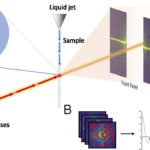Berkeley Lab researchers, in collaboration with scientists from SLAC National Accelerator Laboratory and the Max Planck Institute, have demonstrated that fluctuation X-ray scattering is capable of capturing the behavior of biological systems in unprecedented detail. Although this technique was first proposed more than four decades ago, its implementation was hindered by the lack of sufficiently powerful X-ray sources and associated detector technology, sample delivery methods, and the means to analyze the data. The team developed a novel mathematical and data analyses framework that was applied to data obtained from DOE’s Linac Coherent Light Source (LCLS) at SLAC. This breakthrough was recently reported in the Proceedings of the National Academy of Sciences (PNAS).
M-TIP Algorithm Enables New Approach to Imaging Single Biological Particles
As part of an international team, researchers with Berkeley Lab’s Center for Advanced Mathematics for Energy Research Applications (CAMERA) employed their multi-tiered iterative phasing (M-TIP) algorithm to process X-ray free laser (XFEL) data taken from single virus particles and resolve their nanometer-scale structures in 3D. The new approach circumvents several challenges of imaging biomolecules that do not crystallize well, such as the random orientations of particles in solution and the asymmetrical structures of many viruses and proteins. Jeff Donatelli of the Computational Research Division’s Mathematics Group and Peter Zwart and Kanupriya Pande of the Biosciences Area’s Molecular Biophysics and Integrated Bioimaging (MBIB) division contributed to the work, the results of which were published in Physical Review Letters. Read more from the Berkeley Lab News Center.
Was this page useful?





